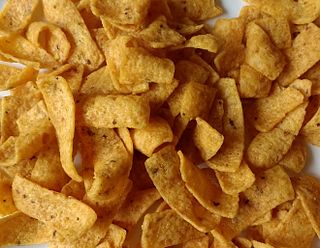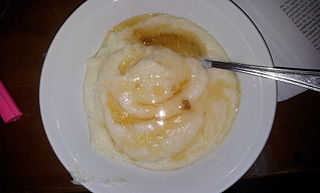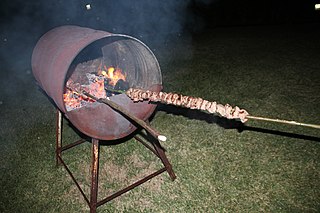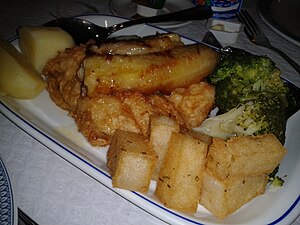
Cornmeal is a meal ground from dried corn. It is a common staple food, and is ground to coarse, medium, and fine consistencies, but not as fine as wheat flour can be. In Mexico, very finely ground cornmeal is referred to as corn flour. When fine cornmeal is made from maize that has been soaked in an alkaline solution, e.g., limewater, it is called masa harina, which is used for making arepas, tamales and tortillas. Boiled cornmeal is called polenta in Italy and is also a traditional dish and bread substitute in Romania.

Fried rice is a dish of cooked rice that has been stir-fried in a wok or a frying pan and is usually mixed with other ingredients such as eggs, vegetables, seafood, or meat. It is often eaten by itself or as an accompaniment to another dish. Fried rice is a popular component of East Asian, Southeast Asian and certain South Asian cuisines, as well as a staple national dish of Indonesia. As a homemade dish, fried rice is typically made with ingredients left over from other dishes, leading to countless variations. Fried rice first developed during the Sui Dynasty in China and as such all fried rice dishes can trace their origins to Chinese fried rice.
Jamaican cuisine includes a mixture of cooking techniques, flavours and spices influenced by Amerindian, African, Irish, English, French, Portuguese, Spanish, Indian, Chinese and Middle Eastern people who have inhabited the island. It is also influenced by the crops introduced into the island from tropical Southeast Asia, many of which are now grown locally. A wide variety of seafood, tropical fruits and meats are available.

Cheetos is a crunchy corn puff snack brand made by Frito-Lay, a subsidiary of PepsiCo. Fritos creator Charles Elmer Doolin invented Cheetos in 1948, and began national distribution in the U.S. The initial success of Cheetos was a contributing factor to the merger between The Frito Company and H.W. Lay & Company in 1961 to form Frito-Lay. In 1965 Frito-Lay became a subsidiary of The Pepsi-Cola Company, forming PepsiCo, the current owner of the Cheetos brand.

Fritos is an American brand of corn chips and dipping sauces that was created in 1932 by Charles Elmer Doolin and produced since 1961 by the Frito-Lay division of PepsiCo. Unlike the similar tortilla chips, which are made from cornmeal and use the nixtamalization process, Fritos are made by deep-frying extruded whole cornmeal. It is one of two brands representing Frito-Lay along with Lay's.

Queso blanco, literally white cheese in Spanish, can refer to many different kinds of cheeses whose only common trait is their white color. The specific cheese referred to depends on the region.

A hush puppy is a small, savory, deep-fried round ball made from cornmeal-based batter. Hushpuppies are frequently served as a side dish with seafood and other deep-fried foods.

Corn chips are a snack food made from cornmeal fried in oil or baked, usually in the shape of a small noodle or scoop. Corn chips are thick, rigid and very crunchy. Corn chips have the strong aroma and flavor of roasted corn, and are often heavily seasoned with salt.

Mielie meal, also known as mealie meal or maize meal, is a relatively coarse flour made from maize or mealies in Southern Africa, from the Portuguese milho. It is also known by various other indigenous language names depending on the locality or country. It was originally brought to Africa from the Americas by the Portuguese.

A crab cake is a variety of fishcake that is popular in the United States. It is composed of crab meat and various other ingredients, such as bread crumbs, mayonnaise, mustard, eggs, and seasonings. The cake is then sautéed, baked, grilled, deep fried, or broiled. Crab cakes are traditionally associated with the area surrounding the Chesapeake Bay, in particular the states of Maryland and Virginia. Although the earliest use of the term "crab cake" is commonly believed to date to Crosby Gaige's 1939 publication New York World's Fair Cook Book in which they are described as "Baltimore crab cakes," earlier usages can be found such as in Thomas J. Murrey's book Cookery with a Chafing Dish published in 1891.
Andalusian cuisine is the cuisine of Andalusia, Spain. Notable dishes include gazpacho, fried fish, the jamones of Jabugo, Valle de los Pedroches and Trevélez, and the wines of Jerez, particularly sherry. The oldest known cookbook of Andalusian cuisine dates from the 14th century.

Fried green tomatoes are a culinary dish usually found in the Southern United States, made from unripe (green) tomatoes coated with cornmeal and fried.

Espetada is the Portuguese term used for the technique of cooking food on skewers, and for the dishes prepared that way. Espetada is a traditional dish in Portuguese cuisine.

Johnnycake, also known as journey cake, johnny bread, hoecake, shawnee cake or spider cornbread, is a cornmeal flatbread, a type of batter bread. An early American staple food, it is prepared on the Atlantic coast from Newfoundland to Jamaica. The food originates from the indigenous people of North America. It is still eaten in the West Indies, Dominican Republic, Saint Croix, The Bahamas, Colombia, Bermuda, Curaçao and Florida as well as in the United States and Canada.

Cuchifritos or cochifritos refers to various fried foods prepared principally of pork in Spanish and Puerto Rican cuisine. In Spain, cuchifritos are a typical dish from Segovia in Castile. The dish consists of pork meat fried in olive oil and garlic and served hot. In Puerto Rico they include a variety of dishes including morcilla, papas rellenas, and chicharron, and other parts of the pig prepared in different ways. Some cuchifritos dishes are prepared using plantain as a primary ingredient. Cuchifritos vendors also typically serve juices and drinks such as passionfruit, pineapple, and coconut juice, as well as ajonjolí, a drink made from sesame seeds.

Dominican cuisine is made up of Spanish, indigenous Taíno, Middle-Eastern and African influences. Many Middle-Eastern dishes have been adopted into Dominican cuisine, such as the "Quipe" that comes from the Lebanese kibbeh.

Sorullos are a fried cornmeal-based dish that is a staple of the Puerto Rican cuisine. Sorullos are served as a side dish or as appetizers, and are sometimes stuffed with cheese. They can be served with mayoketchup, coffee or dusted in confectioners' sugar.

Bolo do caco is a circular Madeiran flatbread, shaped like a cake and thus called bolo. It is traditionally cooked on a caco, a flat basalt stone slab. The bread is usually served with garlic butter, or eaten as a sandwich with octopus, espetada, milho frito or as a prego (steak) sandwich.
















